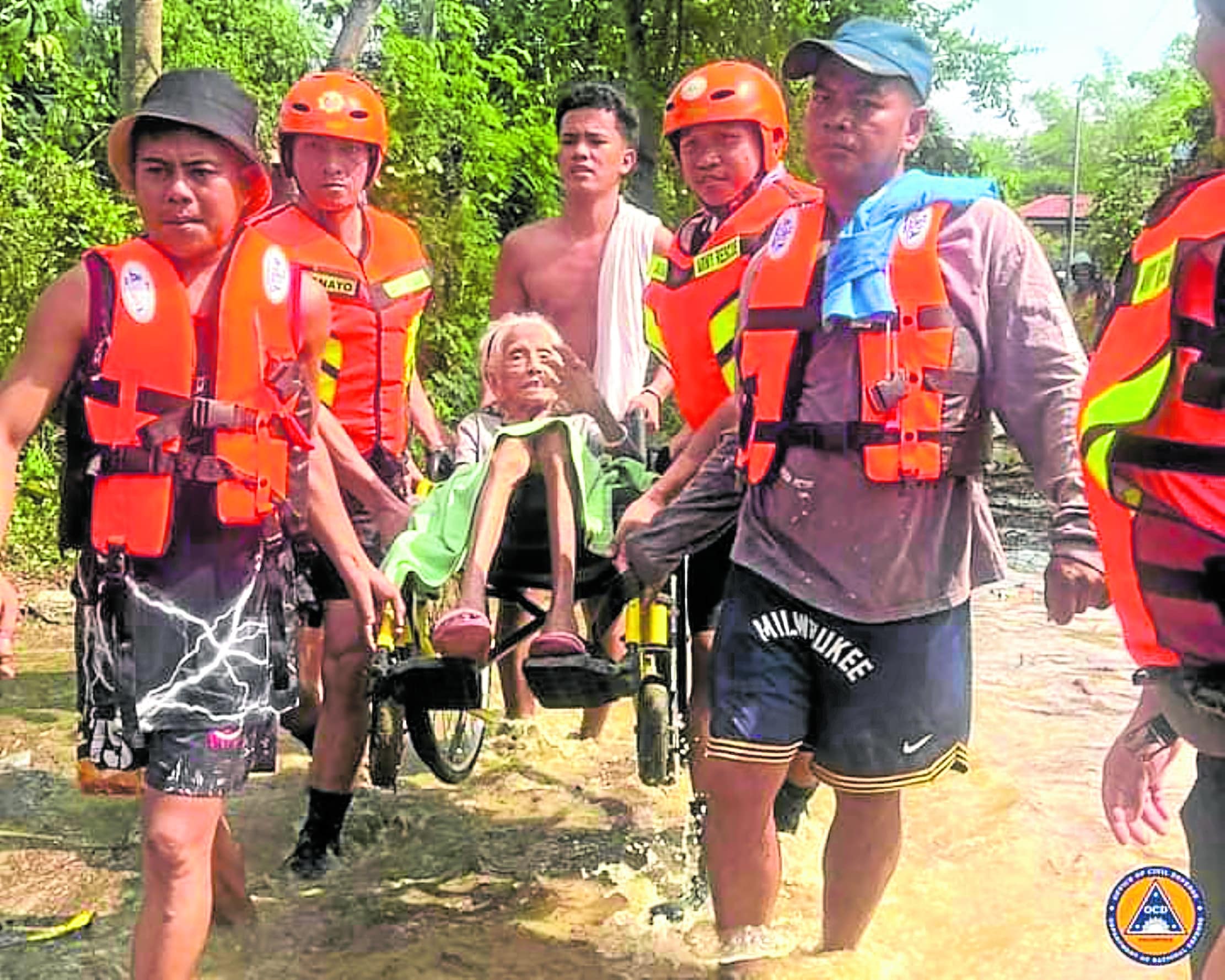Ofel lashes Cagayan as Pepito nears Luzon

PRIORITY The threat of massive flooding due to Supertyphoon “Ofel” (international name: Usagi) prompts a preemptive evacuation in Solana town, Cagayan. Responders have started assisting residents, especially the elderly, in this photo taken on Thursday. —OFFICE OF CIVIL DEFENSE-CAGAYAN VALLEY
TUGUEGARAO CITY — Supertyphoon Ofel (international name: Usagi) made a powerful landfall over Baggao, Cagayan, at 1:30 p.m. on Thursday, bringing with it torrential rains and howling winds that whipped through the province.
The Philippine Atmospheric, Geophysical and Astronomical Services Administration (Pagasa) said Ofel struck with sustained winds exceeding 185 kilometers per hour, forcing the agency to raise Tropical Cyclone Wind Signal (TCWS) No. 5 — the highest level of alert for extreme weather — over Sta. Ana and Gonzaga towns, the northeastern portions of Cagayan.
Pagasa said the typhoon could make another landfall over the Babuyan Islands Thursday night following its initial landfall before exiting the Philippine area of responsibility (PAR).
As of the 5 p.m. bulletin of Pagasa, Ofel has weakened over mainland Cagayan, although it remained within the typhoon category and was located in the vicinity of Gonzaga.
After Ofel, Pagasa expects Tropical Storm Man-yi (to be named Pepito once it enters PAR) to hit Luzon either Saturday or Sunday.
Article continues after this advertisementREAD: Pepito enters PAR, may become a typhoon
Article continues after this advertisementEvacuation
Residents in Cagayan said they experienced intense winds and heavy rains as the supertyphoon prompted local authorities to implement a forced evacuation at Barangay Casambalangan in Sta. Ana town on Thursday morning.
Located near the coast, the village is at risk of a storm surge during typhoons.
In Gonzaga, residents were seen tying down their rooftops as Ofel drew near, anticipating its strong impact.
Close to 200 residents sought refuge at Gonzaga National High School on Thursday as the typhoon lashed through Cagayan.
A preemptive evacuation was also implemented in the towns of Solana, Buguey, and Aparri due to flood risks from heavy rains brought by the typhoon.
Solana was placed under Signal No. 3 while Buguey and Aparri were under Signal No.4 and residents there were advised to take necessary precautions as strong winds and continuous rainfall persisted.
Crowded shelters
In Cagayan’s capital city of Tuguegarao, which was under Signal No. 3, at least 12,866 individuals, or 3,918 families, from 38 low-lying villages remain affected by flooding, with most evacuees not yet permitted to return home.
Due to the high number of evacuees in the city, temporary shelters have been set up in schools, village halls, churches, and demonstration farms.
READ: LIVE UPDATES: Typhoon Ofel
Rescuers also began to face health challenges, including waterborne illnesses and exhaustion, because of the consecutive storms that hit Cagayan and nearby areas, according to Ruelie Rapsing, the Cagayan provincial disaster risk reduction officer.
Fever, fatigue
At a press briefing on Thursday, Rapsing and Dr. Roderick Ramirez, Tuguegarao City’s disaster risk management officer, confirmed that some responders have been affected by colds, fevers, and fatigue after prolonged exposure to floodwaters and rain.
Rapsing said additional responders have been assigned to support ill and fatigued rescuers.
The provincial government also reported the recovery of the body of Jonyfer Callueng, 37, along the Cagayan River in Amulung town. Callueng had been missing at the height of Severe Tropical Storm “Kristine” (Trami).
Cagayan, Isabela, and other areas in the Cagayan Valley have been battered by a series of storms, beginning with Kristine on Oct. 24, which left widespread destruction in its wake. This was swiftly followed by Supertyphoon “Leon” (Kong-rey), which struck between Oct. 28 and Oct. 29, and then Typhoon “Marce” (Yinxing) on Nov. 7.
Most recently, Typhoon “Nika” (Toraji) swept through the region this week, further intensifying the challenges for both residents and responders.
Damage piling up
The National Disaster Risk Reduction and Management Council (NDRRMC) said on Thursday that the country suffered an additional P320 million in damage to infrastructure due to Nika and Ofel, affecting 309, 518 individuals or 85,415 families.
The amount is in addition to the P17.5 billion in damage to infrastructure and agriculture that the NDRRMC reported earlier due to the earlier typhoons that hit the country.
The NDRRMC earlier said the death toll due to Kristine and Leon reached 160 and affected more than 9.6 million individuals, or 2.4 million families, before leaving PAR.
Nika and Ofel are the 14th and 15th typhoons to hit the Philippines this year, and another storm was expected to enter PAR on Thursday.
In its latest bulletin, the disaster agency said two individuals were reported injured in Central Luzon due to Nika and Ofel, while 26,923 people, or 8,676 families, were staying in evacuation centers.
New storm
A total of 2,394 houses were also damaged, of which 1,921 were in the Cagayan Valley region with 1,921.
In the Bicol region, local officials and residents who are yet to fully recover from the devastation left by Kristine were already preparing for Man-yi.
According to the state weather bureau, heavy to intense downpours that could reach up to 100 millimeters to 200 millimeters could be felt starting Saturday.
Pagasa said Man-yi was expected to enter PAR Thursday night and make landfall over the eastern coast of southern Luzon by Saturday or Sunday, based on its current track.
It said Man-yi has maximum sustained winds of 85 kph near the center and gustiness of up to 105 kph.
However, it is expected to strengthen into a severe tropical storm on Thursday and may reach the typhoon category by Friday morning, according to Pagasa. —WITH REPORTS FROM NESTOR CORRALES, CLARENCE ROI GILLEGO, MA. APRIL MIER-MANJARES AND MICHAEL B. JAUCIAN